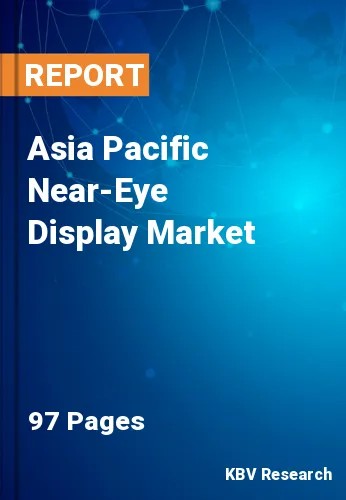The Asia Pacific Near-Eye Display Market would witness market growth of 25.4% CAGR during the forecast period (2022-2028).
A head-up display is a projection system that projects a brightly lit video or image onto a transparent surface. A head-up display's principal aim is to eliminate the need for drivers to shift their gaze from the road to the entertainment panel. These displays project information like turn-by-turn navigation, posted traffic signs, current speed, and blind-spot alarms straight into the drivers' or pilots' field of view, allowing them to keep their focus forward, where danger lurks. Head-up displays were originally designed for defense and military aircraft, but they have recently found appeal in a number of high-end cars.
A microdisplay is a screen with a diagonal size of less than two inches. Microdisplays are increasingly being used in consumer electronic goods such as smartwatches, smart glasses, smartphones, head-mounted displays (HMDs), and digital camera viewfinders. These also have SEGA (super extended graphics array) resolution, which improves seeing angle and brightness for a better user experience. Furthermore, throughout the forecast period, increased demand for nanotechnology devices to identify micro-sized elements is expected to fuel market expansion.
China is a key market player in the automotive industry in this region. China's car output is estimated to exceed 30 million units by 2020, according to the Chinese central government. Furthermore, the organization predicted that by 2025, the country's automotive output will exceed 35 million units. The need for HUD is expected to develop in lockstep with the growth of the automobile industry, increasing the market's growth.
Additionally, China is accelerating the standardization of autonomous vehicles and advanced driver assistance technologies (ADAS). The Chinese government's Ministry of Industry and Information Technology recently announced the primary working principles of Intelligent Connected Vehicle Standardization for 2018, in order to encourage and facilitate the expansion of the intelligent connected car sector. China confronts a number of challenges, including rising air traffic, inclement weather, and growing pollution levels. Authorities are taking a number of steps, including mandating the use of HUDs. For example, the Chinese Civil Aviation Administration (CAAC) has made HUD required for all Chinese carriers.
The China market dominated the Asia Pacific Near-Eye Display Market by Country in 2021, and would continue to be a dominant market till 2028; thereby, achieving a market value of $687.8 million by 2028. The Japan market is experiencing a CAGR of 24.7% during (2022 - 2028). Additionally, The India market would exhibit a CAGR of 26.2% during (2022 - 2028).
Based on Device Type, the market is segmented into VR Devices, AR Devices, and Others. Based on Vertical, the market is segmented into Consumer, Automotive, Aerospace & Defense, Medical, and Others. Based on Technology, the market is segmented into TFT LCD, AMOLED, LCoS, OLEDOS, MicroLED, and DLP & Laser Beam Scanning. Based on countries, the market is segmented into China, Japan, India, South Korea, Singapore, Malaysia, and Rest of Asia Pacific.
Free Valuable Insights: The Worldwide Near-Eye Display Market is Projected to reach USD 6.7 Billion by 2028, at a CAGR of 25%
The market research report covers the analysis of key stake holders of the market. Key companies profiled in the report include Sony Corporation, Himax Technologies, Inc., Kopin Corporation, eMagin Corporation, BOE Technology Group Co., Ltd., Texas Instruments, Inc., Tianma Microelectronics Co., Ltd., Tianma Microelectronics Co., Ltd., MICROOLED Technologies, and Syndiant, Inc.
By Device Type
By Vertical
By Technology
By Country
Our team of dedicated experts can provide you with attractive expansion opportunities for your business.

